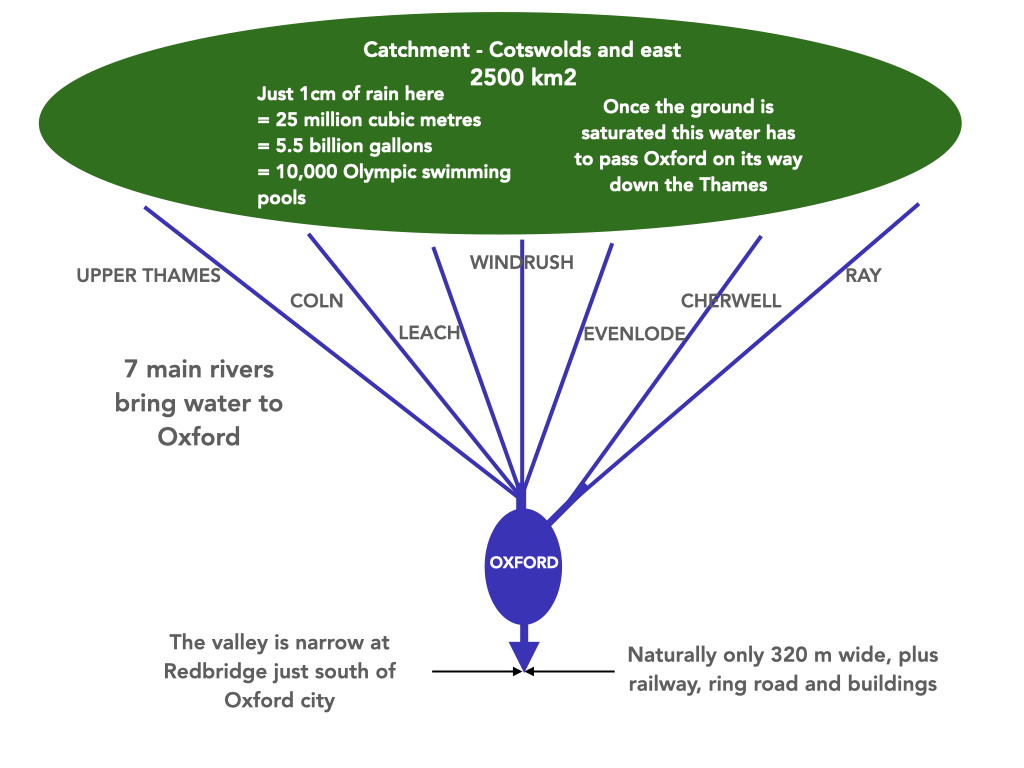The diagram shows why Oxford floods, and the photo from 1947 why something needs to be done to reduce the risk. Although measures have been taken since 1947 the risk remains high and climate change may well make things worse.


The diagram shows why Oxford floods, and the photo from 1947 why something needs to be done to reduce the risk. Although measures have been taken since 1947 the risk remains high and climate change may well make things worse.


Members of OFA steering group, along with Councillor Colin Cook, and Stephanie Ouzman (a member of MP Layla Moran’s staff), met with Council officers and their consultants WYG on 27 April 2018 to try to obtain answers to a series of questions about the proposed Seacourt P&R extension. Subsequent to the meeting there was a further email exchange and answers were provided to a number of outstanding points by the Council. We appreciate having had this opportunity for dialogue about the issues, and now feel we understand what is being proposed.
It’s clear from the response from the Council that the planning documents did not provide a clear reference to the use of an impermeable membrane at the site. It wasn’t spelled out in the application, and the documents give no details of the tanking and how this would work. This has now been explained to us.
We believe we should have been able to get answers, as of right, on points of issue like this through the planning consultation. The fact that we couldn’t was a failure of the process, and below the standards we have observed in other applications locally. The County (LLFA), Environment Agency and planning officer didn’t, in our view, fully understand what WYG were proposing – this is clear from correspondence with them during and subsequent to the planning process. Councillors, therefore, approved a proposal which had information gaps in it on flood risk, and which they couldn’t have fully understood. In our view this happened because the planning outcome had already been pre-determined, and our queries were ignored because the process was designed to secure a particular outcome.
Now that we know what’s actually proposed, we don’t believe (as far as we can judge) that the development poses an immediate and direct flood risk to local properties, which is obviously a welcome outcome. But all development in Flood Zone 3B by its very nature creates a risk to the consistent and predictable functioning of floodplains. Hence planning policy, which incorporates learning outcomes from decades of previous developments in areas subject to flooding, prohibits such developments because the medium and long-term consequences can be unexpected and far-reaching.
We believe the development is inconsistent with planning guidelines – building in the floodplain and Green Belt – but recognise the planning officer advised otherwise, and that Councillors agreed with his interpretation. We regret that the Secretary of State did not choose to examine this issue, and believe the Council’s decision sets an unfortunate planning precedent. We also remain unconvinced of the need case.
The car park extension will be an additional source of pollution during a flood, and there is no way to stop this. This is undesirable, and a negative environmental impact. The Seacourt P&R extension is just to the north of OFAS which has an ‘environmental vision’ aiming to improve freshwater habitat – a vision the Council signed up to.
If the development goes ahead, we’ll be watching with interest to see how often if floods and how the local authority deals with this. At times of flooding the car park will be a potential source of risk to users and members of the public. We will also continue to be vigilant about further planning applications brought forward by the Council, as the process has left us feeling we can’t rely on the local planning authority, or members of Council planning committees, to safeguard the public interest. We hope public concerns will be better addressed should any similar situation arise in future.
An independent review of the Oxford Flood Alleviation Scheme, commissioned by Vale of White Horse District Council, has confirmed that the proposed flood alleviation scheme will have no impact on communities downstream in the Vale or South Oxfordshire.The Oxford Flood Alleviation Scheme will be approximately three miles long and will run from the north of Botley Road to re-join the River Thames near Kennington. The scheme will reduce the risk of flooding from the River Thames to all homes and businesses in Oxford, as well as to services and major transport routes into the city, particularly around Botley and Abingdon Road. This will help avoid a repeat of the disruption and damage caused by floods in 2007, 2012 and 2013/14.Communities downstream were concerned that the Oxford scheme would increase their flood risk.In 2016 the Environment Agency produced technical modelling using sophisticated computer programmes which showed that the scheme would not change flood risk of communities downstream. As with all Environment Agency modelling this was independently checked.In 2017, due to local concerns, Vale of White Horse District Council commissioned independent expert, Water Resource Associates, to further review the work carried out by the Environment Agency.This independent review confirms that the Oxford Flood Alleviation Scheme will not put communities downstream at any greater risk of flooding. To read the full Water Resource Associates’ review visit whitehorsedc.gov.uk/OFAS.Cllr Matthew Barber, Leader of Vale of White Horse District Council, said: “This is very positive news. Although we have always been supportive of the Oxford scheme it was important for us to listen and respond to our residents’ concerns. We’re pleased that the independent review findings confirm the Environment Agency’s modelling, providing much needed reassurance for downstream communities that they won’t be impacted by the new scheme.“We know communities by the River Thames will always have concerns over flooding and we will continue to work with them and Environment Agency on feasible and appropriate flood prevention projects, such as the St Helen’s Mill scheme in Abingdon.”Dr Harvey Rodda from Water Resource Associates said: “After receiving all of the documentation from the Environment Agency and their consultants working on the OFAS we were pleased that a thorough investigation on the potential downstream impacts had taken place and the results showed there would be a negligible impact of flooding on the areas along the downstream reach of the River Thames from Sandford to Mapledurham.”Jo Larmour, Project Director at the Environment Agency said: “The Oxford Flood Alleviation Scheme will have a positive impact on people and communities outside of Oxford. The scheme will reduce disruption to roads and the railway during flooding, a relief to those who commute into Oxford or travel on surrounding transport links. This will also benefit the approximately 7 million people who visit Oxford every year.”
Liz Sawyer, who recently joined the OFA Steering Group, addressed Oxford City’s Full Council on 6 February 2017, about the potential risk to life posed by the proposed extension to Seacourt P&R.
There is also, as the photograph above shows so vividly, the potential for damage to the car park itself – and of course to vehicles. The Automobile Association’s ‘Flood Facts’ quoted in Liz’s address set out the risks of floodwaters very clearly.
Liz’s address can be downloaded here (pdf).